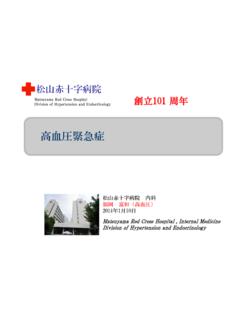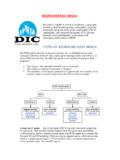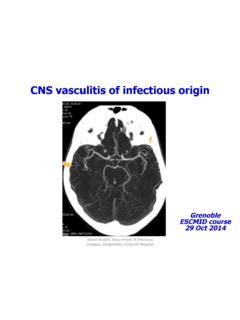Transcription of RIZAMELT 1. Product Name 2. Qualitative and …
1 Page 1 of 12 NEW ZEALAND DATA SHEETRIZAMELT1. Product NameRizamelt, 5 mg and 10 mg, orodispersible tablet2. Qualitative and Quantitative CompositionEach orodispersible tablets contains 5 mg rizatriptan (corresponding to mg of rizatriptan benzoate), or 10 mg of rizatriptan (corresponding to mg of rizatriptan benzoate). Excipient with known effect: the full list of excipients, see section Pharmaceutical FormThe 5 mg RIZAMELT orodispersible tablet is a white to off-whitecoloured, round, flat faced bevelled edged tablet, debossed with M on one side and RN1 on the other 10 mg RIZAMELT orodispersible tablet is a white to off-white coloured, round, flat faced bevelled edged tablet, debossed with M on one sideand RN2 on the other Clinical Therapeutic indicationsRIZAMELT is indicated for the acute treatment of migraine attacks with or without aura.
2 And method of administrationDoseClinical experience has shown that the 10 mg rizatriptan dose provides the optimal clinical benefit. Onset of relief ( , reduction of headache pain to mild or none) can occur within 30 minutes after dosing. Do not halve the orodispersible Doses should be separated by at least 2 hours; no more than 30 mg should be taken in any 24-hour period. For headache recurrence within 24 hoursIf headache returns after relief of the initial attack, further doses may be taken. The above dosing limits should be observed. Page 2 of 12 After non-response The effectiveness of a second dose for treatment of the same attack, when an initial dose is ineffective, has not been examined in controlled trials.
3 Clinical studies have shown that patients who do not respond to treatment of an attack are still likely to respond to treatment for subsequent attacks. Special populationsPatients receiving propranololPlasma concentrations of rizatriptan may be increased by concomitant administration of propranolol (see section ). The 10 mg dose is not appropriate for these patients. The physician should consider alternative therapies for these patients, for example, other 5-HT1B/1D agonists that do not have this drug of administrationIn clinical trials rizatriptan was administered without regard to orodispersible tablets are packaged in blister strips. Patients should be instructed not to remove the tablet from the blister strip until just prior to dosing.
4 The blister pack should be peeled open with dry hands and the orodispersible tablet placed on the tongue, where it will dissolve and be swallowed with the saliva. Administration with liquid is not necessary. is contraindicated in patients with: hypersensitivity to rizatriptan or any of the ingredients concurrent administration of monoamine oxidase inhibitors (MAOIs), or use within 2 weeks of discontinuation of MAOI therapy (see section ). Based on the mechanism of action of this class of compounds, RIZAMELT is also contraindicated in patients with: uncontrolled hypertension established coronary artery disease, including ischaemic heart disease (angina pectoris, history of myocardial infarction, or documented silent ischaemia), signs and symptoms of ischaemic heart disease, or Prinzmetal's angina history of stroke or transient ischaemic attack (TIA) peripheral vascular disease, including (but not limited to) ischaemic bowel warnings and precautions for useRIZAMELT should only be administered to patients in whom a clear diagnosis of migraine has been established.
5 RIZAMELT should not be administered to patients with basilar or hemiplegic migraine. RIZAMELT should not be used to treat "atypical" headaches, , those that might be associated with potentially serious medical conditions ( , stroke, ruptured aneurysm) in which cerebrovascular vasoconstriction could be harmful. Step 1 Step 2 Step 3 Step 4 Page 3 of 12 Patients at risk for coronary artery diseaseThere have been rare reports of serious coronary events with this class of medicines including rizatriptan (seesection ). Prior to prescribing this medicine, cardiovascular assessment should be considered in patients at risk for coronary artery disease (CAD) [ , patients with hypertension or diabetes, smokers, and those with strong family history for CAD].
6 Those in whom CAD is established should not be given RIZAMELT (seesection ). Other 5-HT1B/1 DagonistsOther 5-HT1B/1D agonists ( , sumatriptan) should not be used concomitantly with RIZAMELT . Ergotamine-type medicationsAdministration of ergotamine-type medications ( , ergotamine, dihydro-ergotamine or methysergide) and RIZAMELT within 6 hours of each other is not recommended. Although additive vasospastic effects were not observed in a clinical pharmacology study in which 16 healthy males received oral rizatriptan and parenteral ergotamine, such additive effects are theoretically possible. Serotonin syndromeCases of life-threatening serotonin syndrome have been reported during combined use of selective serotonin reuptake inhibitors (SSRIs)/serotonin norepinephrine reuptake inhibitors (SNRIs) and triptans.
7 If concomitant treatment with RIZAMELT and an SSRI ( , sertraline, escitalopram oxalate, and fluoxetine) or SNRI ( , venlafaxine, duloxetine) is clinically warranted, careful observation of the patient is advised, particularly during treatment initiation and dose increases. Serotonin syndrome symptoms may include mental status changes ( , agitation, hallucinations, coma), autonomic instability ( , tachycardia, labile blood pressure, hyperthermia), neuromuscular aberrations ( , hyperreflexia, incoordination) and/or gastrointestinal symptoms ( , nausea, vomiting, diarrhoea) (seesection ). Medication overuse headacheOveruse of acute migraine medications may lead to exacerbation of headache (medication overuse headache).
8 Medication overuse headache may present as migraine-like daily headaches or as a marked increase in frequency of migraine attacks. Detoxification of patients, including withdrawal of the overused medications, and treatment of withdrawal symptoms (which often includes a transient worsening of headache) may be cerebral vasoconstriction syndrome (thunderclap headache)Reversible cerebral vasoconstriction syndrome (thunderclap headache) has been rarely associated with serotonergic agents such as SSRIs or by gender or in individuals of various ethnic originsThere is no evidence that gender or ethnic origin has any influence on the efficacy or adverse effects of rizatriptan.
9 In controlled trials, there were no apparent differences in overall adverse experience rates or efficacy of treatment between males and females, or between various ethnic patients should be informed that RIZAMELT orodispersible tablets contain phenylalanine (a component of aspartame). Each 5 mg RIZAMELT orodispersible tablet contains 5 mg of aspartame ( mg phenylalanine), and each 10mg RIZAMELT orodispersible tablet contains 10 mg of aspartame ( mg phenylanaline).Paediatric use Children (under 12 years of age)Page 4 of 12 There are no data available on the use of rizatriptan in children under 12 years of age. Therefore, its use in this age group is not (12-17 years of age)In placebo-controlled study, the efficacy of rizatriptan tablets (5 mg) was not established.
10 Adverse events observed in this clinical trial were similar in nature to those reported in clinical trials in adults. The use of RIZAMELT in patients under 18 years of age is not in the elderly The pharmacokinetics of rizatriptan were similar in elderly (aged 65 years) and in younger adults. Because migraine occurs infrequently in the elderly, clinical experience with rizatriptan is limited in such patients. In clinical trials, there were no apparent differences in efficacy or in overall adverse experience rates between patients under 65 years of age and those 65 and above (n = 17). Effect on laboratory testsIn long-term controlled clinical trials, there were no clinically relevant, medicine-related changes in laboratory with other medicines and other forms of interactionPharmacokinetic interactionsPharmacokinetic interaction studies were carried out with the MAO-A inhibitor, moclobemide; the selective serotonin reuptake inhibitor (SSRI), paroxetine; propranolol and two other beta-blockers, nadolol and metoprolol; and oral contraceptives.













